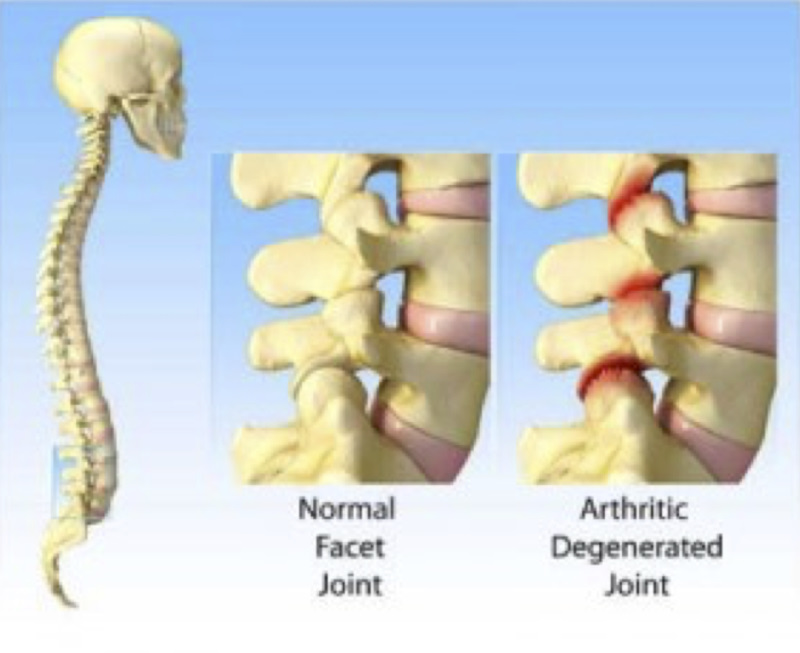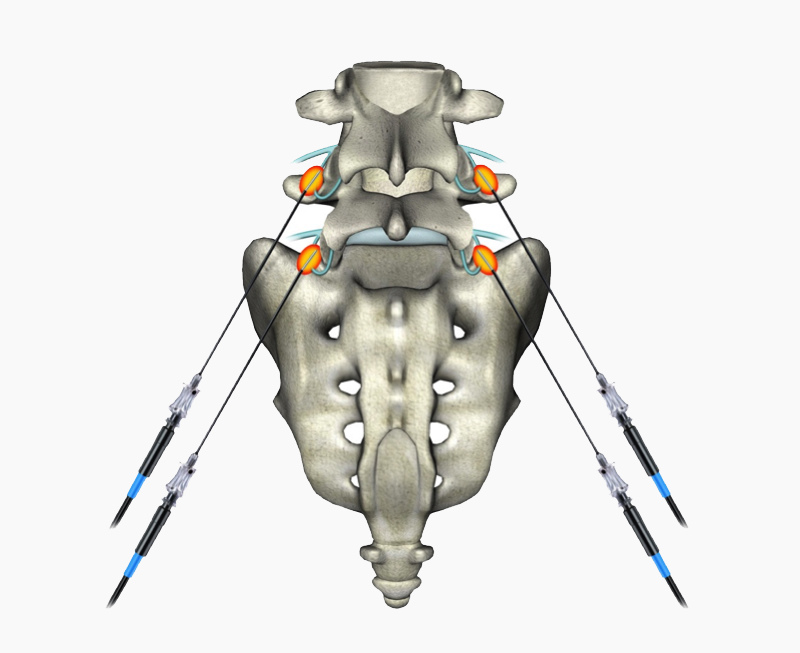- A facet joint neurotomy (FJN) (also called a rhizotomy) is a procedure used to treat chronic low back or neck pain.
- It involves placing needles near the nerves to the facet joint in the low back or neck, under x ray guidance,
- The nerves are either cauterized (heated), frozen or electrically-pulsed (pulsed radiofrequency) for a few minutes.
- This blocks pain signals coming from the painful facet joints.
- FJN is a common pain procedure which has been well studied.
- The facet joints are small joints on the outside of the spine that act as stabilizers (see picture below).
- These joints can develop arthritis leading to back and neck pain.
- Painful facet joints are responsible for up to 30% back and neck pain, up to 60% of back in older persons.
- Facet pain is usually a dull and aching and can radiate into the buttocks and thighs (back pain), or shoulders and arms (neck pain).
- The pain tends to get worse with activity and lessen at night.
- A ‘test injection’ is often performed with local anaesthetic before the FJN.
- Either the facet nerve (medial branch) is blocked or a facet joint injection is performed.
- These procedures aim to numb the facet joint temporarily to see if it’s the source of the pain.
- These injections are done in an operating theatre with x-ray guidance and sedation.
- Sometimes these ‘test’ facet joint or nerve injections actually work as a pain treatment for weeks-to-months.
- These injections are simple, low risk procedures.
Sometimes, if you have a “good story” for facet pain or a previous good response to a facet joint injections, your doctor may go direct to a FJN without a test injection. The advantages of this include; having only one procedure instead of two, faster pain relief, and greater convenience. The disadvantage is that without a test injection, there is a small risk the FJN won’t work as expected, or of having a complication (see below).
You will need to be fasted on the day of the procedure due to the anaesthetic.
- A small intravenous drip will be inserted in your arm.
- The procedure is done in an operating theatre.
- You will be given medication to make you feel relaxed and sleepy, but not totally ‘knocked out.’
- You will lie on your front on an x-ray operating table.
- Local anaesthetic will be used to numb your back.
- Fine needles are inserted into your back and guided to the correct area using x-ray.
- The needles are either electrically pulsed, heated to 90 degrees to burn the nerve (see picture at bottom), or frozen with a special needle (like dry ice).
- The procedure takes 30-60 minutes, and you will go home the same day.
- Patients who are on blood thinning medication (other than aspirin) will need to stop this (in consultation with their doctor) prior to the procedure.
- Patients who have pacemakers, defibrillators or other implanted medical devices may not be able to have this procedure as the electric current to heat the needles may interfere with them.
- Between 50 to 70% of patients will get a good response to a FJN.
- A good response is a 50% or greater reduction in pain lasting at least three months.
- Often patients have an improvement in function–they can walk more easily and do more of their normal activities.
- Some patients obtain complete relief of pain.
- Some people have multiple causes of back pain (e.g. pain coming from the discs) and a FJN will only help facet joint pain.
- It is important to know that it can take up to 4 weeks for pain relief from a FJN to ‘kick in’.
- The average duration of pain relief from a FRN is around one year.
- This can range from three months to over 2 years.
- The procedure can be safely repeated in the setting of a good result.
The common risks are:
- The procedure may not help in up to 30% of patients
- Some people experience a temporary increase in back or neck pain for days to weeks after the procedure-pain medications can be given to manage this.
- Very rarely there is a long-term increase in spinal pain.
- Bruising and tenderness around the injection site.
The rare risks are:
- Damage to nerves going to the legs, arms, bladder or bowel.
- This is a very rare complication (less than one in 10,000)
- It may result in a painful, numb or weak legs, weak bladder or bowel control-on rare occasions this can last a long time (weeks to months).
- Permanent nerve damage is possible (although even more rare).
- Damage to the spinal cord: This is extremely rare.
- Headaches.
- Dangerous bleeding around spinal cord (very rare).
- Infection (very rare).
- Complications of the anaesthetic, such as breathing problems or pneumonia.


Needles are inserted through the skin to burn the small facet nerves

